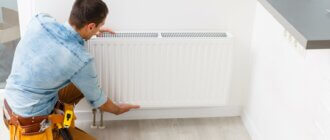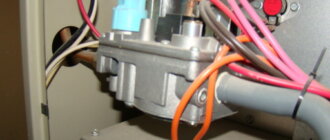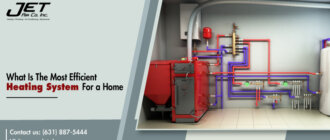Why does my heat pump use auxiliary heat?
Introduction
Are you wondering why your heat pump keeps using auxiliary heat, especially during those cold winter months? If yes, then you’ve come to the right place! Heat pumps are known for their high efficiency and use of renewable energy sources. However, there may be times when they require additional assistance from an auxiliary heating system. In this blog post, we will explore everything you need to know about heat pumps and auxiliary heating systems. We’ll also discuss some tips to reduce the usage of auxiliary heat and when it’s time to call a professional HVAC technician. So sit back, relax, and let’s dive into the world of heat pumps!
What is a Heat Pump?
A heat pump is a heating and cooling system that transfers heat from one place to another. It works by extracting heat energy from the outdoor air or ground and transferring it inside your home during winter months. During summer, the process is reversed, with the heat pump taking hot air from inside and releasing it outside.
Heat pumps are highly efficient because they do not generate heat like traditional furnaces or boilers; rather, they move existing warm air around. This makes them an eco-friendly option for heating and cooling homes.
There are different types of heat pumps available in the market such as air-source, geothermal or water-source. Each type has its own set of pros and cons depending on factors such as climate conditions, installation costs etc.
In summary, a heat pump is a versatile HVAC system that can provide both heating and cooling solutions for your home while consuming less energy than other systems.
Heat Pump Functioning and Efficiency
Heat pumps are a popular choice for both cooling and heating homes. They work by transferring heat from the outdoor air or ground to your home’s interior during colder months, and vice versa during warmer months. This process of heat transfer is what makes them efficient and environmentally friendly.
The efficiency of a heat pump depends on its ability to extract as much warmth as possible from the outside air or ground. The higher its seasonal energy efficiency rating (SEER) and heating seasonal performance factor (HSPF), the better it performs in terms of energy consumption.
To maintain optimal efficiency, it’s important to keep your heat pump well-maintained with regular inspections, filter replacements, and cleaning. A dirty or clogged system can cause poor airflow which can reduce its overall effectiveness.
It’s also important to note that the efficiency of a heat pump can be affected by low outdoor temperatures. As temperatures fall below freezing point, it becomes more difficult for the system to extract sufficient warm air from outside sources.
Proper maintenance along with appropriate climate management will ensure your heat pump runs efficiently throughout the year without relying too much on auxiliary heating systems.
Types of Heat Pumps
Heat pumps are available in different types designed to suit the specific needs of homes and buildings. The most common types include air-source, ground-source (geothermal), and water-source heat pumps.
Air-source heat pumps are popular due to their efficiency. They work by extracting heat from the outdoor air, even when temperatures drop below freezing. This type is best suited for moderate climates where low outdoor temperatures aren’t frequent.
Ground-source or geothermal heat pumps extract heat from the ground through a series of underground pipes filled with refrigerant fluid. These systems are highly efficient but require a larger installation budget than other types.
Water source or hydronic heat pumps extract energy from water sources such as lakes, ponds, or wells. They can be used for heating and cooling applications depending on the temperature of the water source.
Each type has its own pros and cons that should be considered before making a decision on which one to choose for your home or building’s unique requirements.
What is Auxiliary Heat?
Auxiliary heat is a feature found in most heat pumps that helps to supplement the heating process when outdoor temperatures drop too low. It is also known as emergency or backup heat, and it works by using an additional source of heating power to keep your home warm.
Basically, auxiliary heat kicks in when the temperature outside falls below a certain point where the heat pump alone can no longer effectively transfer enough warmth into your home. When this happens, the system automatically switches over to auxiliary mode to ensure proper heating output.
The primary purpose of auxiliary heat is to provide consistent indoor comfort during extremely cold weather conditions. As a result, it’s essential for homeowners who live in areas with prolonged periods of freezing temperatures or harsh winter climates.
While helpful during extreme weather events, auxiliary heat usage comes at a higher cost due to its added energy consumption. Therefore, keeping your home well insulated and regularly maintaining your HVAC system can help reduce its reliance on this supplemental heating method.
Definition and Purpose
Auxiliary heat is a term that confuses many homeowners, especially those who have recently installed a heat pump. Simply put, it refers to an additional heating component that supplements the primary source of heating provided by the heat pump. The purpose of auxiliary heat is to provide warmth when outdoor temperatures are too low for the heat pump to operate efficiently.
The main function of a heat pump is to transfer hot air from one place to another using refrigerant. This means that during winter months, it pulls in warm air from outdoors and transfers it inside your home while doing the opposite during summer.
However, when outdoor temperatures drop below 35-40°F, traditional air-source heat pumps begin struggling and require more energy to produce adequate indoor warmth. That’s where auxiliary or backup electric resistance heating comes into play – it supports the primary system by providing supplemental warmth as needed.
While useful in some situations, relying heavily on auxiliary heating will increase your electricity bill significantly since this type of heater consumes much more energy than your regular HVAC system. Therefore, you should take measures such as proper maintenance and insulation improvement to minimize its usage whenever possible.
How it Works
When the temperature outside drops, a heat pump needs to work harder in order to produce warm air for your home. This is where auxiliary heat comes into play. Auxiliary heat refers to an additional heating source that kicks in when the outdoor temperatures drop too low for a traditional heat pump to effectively operate.
So how does it work? When the temperature outside drops below a certain point (usually around 35-40 degrees Fahrenheit), the heat pump will automatically switch on its backup heating system. This could be electric resistance heaters or a gas furnace, depending on what type of system you have installed.
The main purpose of auxiliary heat is to ensure that your home stays warm and comfortable even during extremely cold weather conditions. By supplementing the primary heating source with backup heating elements, you can avoid having cold spots and uneven temperatures throughout your house.
However, relying too heavily on auxiliary heat can have negative consequences for both your energy bills and your HVAC system’s overall health. That’s why it’s important to take steps to minimize usage whenever possible – such as by keeping indoor temperatures consistent or scheduling regular maintenance appointments with an experienced technician.
Reasons for Heat Pump Using Auxiliary Heat
There are various reasons why your heat pump may use auxiliary heat, especially during low outdoor temperatures. One of the primary reasons for this is that the heat pump may not be able to meet your heating needs on its own when the temperature outside drops below a certain level.
Typically, heat pumps function by extracting warmth from the air or ground outside and using it to warm up your home. However, when temperatures drop too low, there might not be enough warmth available for the unit to work efficiently without assistance.
Another reason could be due to wear and tear on your system since older units tend to struggle more with extreme weather conditions. If you have an aging system that hasn’t been serviced regularly or maintained well over time, then it’s likely that it will need some help from auxiliary heating elements in order to keep up with demand.
If you have improperly sized ductwork or a poorly insulated home, then your heat pump may also require additional support from auxiliary sources. This is because insufficient insulation can cause significant energy loss as hot air escapes through gaps and cracks in walls and ceilings – making it harder for your unit to effectively regulate indoor temperatures without backup assistance.
The Impact of Using Auxiliary Heat
Using auxiliary heat can have a significant impact on your heating bills and overall energy consumption. When the outdoor temperature drops, your heat pump may not be able to keep up with the demand for warmth in your home. This is when auxiliary heat kicks in.
The use of this secondary source of heating can cause an increase in electricity usage and result in higher utility costs. In some cases, it may even overload your electrical system, leading to power outages or malfunctions.
Additionally, using auxiliary heat too frequently can reduce the efficiency of your heat pump and shorten its lifespan. This puts you at risk for expensive repairs or replacement costs down the line.
However, it’s important to note that while using auxiliary heat does come with potential drawbacks, it also serves an important purpose in ensuring that you stay warm during extremely cold temperatures. It’s all about finding a balance between comfort and efficiency.
By being mindful of how often you rely on auxiliary heat and taking steps to reduce its usage when possible (such as through proper insulation), you can minimize its impact on both your wallet and the environment.
Tips to Reduce Auxiliary Heat Usage
Reducing your heat pump’s auxiliary heat usage can help you save money on your energy bills. Here are some tips to help you minimize the use of auxiliary heat:
- Adjust Your Thermostat Settings: Lowering your thermostat by a few degrees can significantly reduce the need for auxiliary heat.
- Use Timer Settings: Programming your thermostat to adjust temperature settings according to your daily routine and outdoor temperatures will reduce unnecessary heating or cooling and conserve energy.
- Maintain Your Heat Pump System: Regular maintenance such as cleaning air filters, maintaining airflow, and lubricating moving parts helps ensure that it runs efficiently.
- Weatherize Your Home: Sealing any drafts around windows and doors will keep warm air inside, reducing the need for additional heating.
- Insulate Your Home: Proper insulation prevents heat loss during winter months, resulting in less work for your system to maintain indoor comfort levels.
By following these simple tips, you’ll not only decrease the amount of time your system relies on costly auxiliary heating but also improve its overall efficiency – ultimately saving you money!
When to Call a Professional HVAC Technician
When it comes to heat pumps, it’s important to know when you should call a professional HVAC technician. While there are some basic troubleshooting steps you can try yourself, certain issues may require the expertise of a trained professional.
One sign that you need to call in an expert is if your heat pump is constantly relying on auxiliary heat even when outdoor temperatures are above freezing. This could indicate a problem with the system’s refrigerant levels or other components.
Another reason to bring in a pro is if your heat pump simply isn’t providing adequate heating or cooling for your home. This could be due to issues with airflow, ductwork, or thermostat settings.
Other potential warning signs include strange noises coming from the unit, foul odors emanating from the vents, and frequent cycling on and off. Any of these symptoms could indicate serious problems that only an experienced technician can properly diagnose and fix.
In general, if you’re unsure about how to address any issue with your heat pump – whether related to auxiliary heating or anything else – it’s always best to err on the side of caution and contact a professional rather than trying to DIY repairs that may end up doing more harm than good.
Conclusion
Understanding why your heat pump is using auxiliary heat is crucial for maintaining its efficiency and preventing unnecessary expenses. Auxiliary heat serves a critical purpose in keeping your home at a comfortable temperature during extremely low outdoor temperatures or when the heat pump malfunctions.
However, excessive use of auxiliary heat can significantly impact your energy bills and reduce the overall efficiency of your system. Therefore, it’s essential to take steps to reduce its usage by checking for air leaks, changing air filters regularly, and scheduling annual maintenance.
If you notice that your heat pump continuously uses auxiliary heating or suspect any malfunctioning with the system, don’t hesitate to call an HVAC professional immediately. They will diagnose and fix any issues with the unit before they escalate into more significant problems.
By following these tips, you can maintain optimal performance from your system while minimizing energy consumption costs. A well-maintained and functioning heat pump not only saves money but also contributes towards reducing carbon emissions – making it an eco-friendly option for keeping warm during cold weather conditions.



